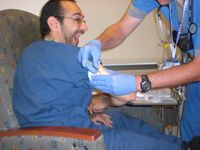How to save a life
Posted: August 26, 2010
by Kathryn Stroppel
Student doctor donates bone marrow, extends a second chance.
During his first year of medical school at ATSU-KCOM, Chicago native Jonathan Terry, D.O., ’09, learned his father had acute myelogenous leukemia, AML.
Nothing short of a bone marrow transplant could save him.
Although a match was identified, the elder Terry did not survive to complete the procedure, losing his battle during his son’s first-quarter final exams. One year later, Dr. Terry added his name to the national bone marrow registry, thinking he would never be called. And with good reason: out of 110 people on the registry, one – or none – will be contacted.
But the call came. Two years after he joined the registry, in 2009, he matched anonymously with a 50-year-old man with AML – the same disease that took his father.
Dr. Terry compares the probability of such a match to winning the lottery because of the small number of those on the registry, an extremely low probability for a match, and the fact that he is Jewish, a minority that lowers the odds of a successful match even further.
A bone marrow match, in which whole DNA sequences must match, is more complex than a blood match, he says. Most people who are on the registry are Caucasian, and overall there’s a limited expression of genes, particularly for minorities.
Nevertheless, despite the odds, Dr. Terry traveled to the University of Maryland in Baltimore – one of five such transplant centers in the United States – to donate his bone marrow. First, he was given five shots of Neupogen, or Filgrastim, which is a granulocyte-stimulating factor that caused his bone marrow to secrete extra CD34 stem cells into the peripheral circulation. The drug, he says, made him experience flu-like symptoms such as bone pain, headache, and extremely high white blood cell counts, representing the stem cells in his peripheral circulation awaiting collection.
Next, with a large-bore IV in each arm, he experienced five hours of plasmapheresis, similar to dialysis, during which his blood was routed, sorted, and returned back to his body after the stem cells had been removed.
Although he was only in the hospital for one day, start to end his donation experience lasted one week. His only thought: “I hope my recipient survives.”
It was a small amount of discomfort, he says, but “incredibly important and literally a matter of life and death for the person on the other end. The thing that surprised me was how easy and relatively pain-free it was. The biggest sacrifice, if you can call it that, was time. But I was back at work the next day – my residency was very helpful in supporting me. It’s a small amount of pain to have the potential to save a life.”
In Dr. Terry’s case, a life indeed was saved. His recipient, known only as “50-year-old male” to Dr. Terry, referred to as “23-year-old male” in their correspondence, was soon discharged from the hospital despite a less than 50 percent chance of graft success.
The survival rate for five years still hovers only around 44 percent, but as Dr. Terry notes, “we can all imagine what someone can do with a few extra years of life without chemo – let alone the distinct possibility of prolonged success.”
His marrow recipient, whose name he may learn yet this summer – the registry requires a one-year wait period before names of donors and recipients are released – has returned to work and is enjoying his new lease on life. Dr. Terry, in the meantime, looks forward to someday meeting this anonymous “50-year-old male,” who now shares a part of him.
“I had been praying for more time to be with my family,” says the recipient, one of seven siblings, who has been married 29 years, and has two adult children.
“My prayers have been answered, and I now have more time to spend with my family. Day by day, one day at a time. For your gift not only helps me, it helps my whole family.”
“Words,” he says, “cannot express how important your donation was to me. All I can say is thank you for the opportunity to be cured from this disease. Thanks for taking time out of your life to help me.”